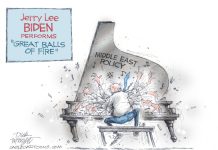We see a new tone in diplomatic affairs between the United States and China, a real change in how both sides view the relationship. Top officials now talk openly about competition — much more so than a few years ago.
The fact is, that the U.S. and China have long been rivals, competing for influence and advantage. Both want the same thing: to be the final arbiter of political and economic affairs in East and Southeast Asia.
When President Barack Obama called for a “pivot” toward Asia — for drawing down U.S. power in the Middle East and repositioning military resources in the Pacific — a key goal was to check China’s ambitions and to reorient the region away from China and toward the United States. Obama also wanted to incorporate China into the global economy and accommodate China’s rise.
From the standpoint of Obama’s critics, accommodating China was a mistake. Many of these critics favor an aggressive posture toward China. President Donald Trump’s “America First” agenda came with a strong dose of anti-Chinese rhetoric and complaints that China had taken advantage of us. In many ways, Trump’s foreign policy was characterized by an anti-China agenda of tariffs, trade wars and sanctions, as the U.S.-China relationship reached a historic low point.
China shares the blame for this, of course. When Xi Jinping became China’s leader in 2012, he asserted control over the Chinese economy, dragging China “into the 21st Century,” as he said. He implemented massive building and economic programs. He clamped down on dissent and ushered in a new era of state control over communication and information.
Xi made no secret of the fact he wanted China to become a global military power as well as an economic titan. He aggressively promoted the Chinese yuan as an international currency and launched the Belt and Road initiative, a massive infrastructure project across Asia and Africa. Recently, tensions have flared over a World Health Organization investigation of the origins of the COVID-19 pandemic in Wuhan, China. The U.S. and its allies have accused China of genocidal policies toward the Uighur population in Xinjiang province.
The U.S. rejects China’s territorial claims in the South China Sea, which threaten our allies. The status of Taiwan is another sore point: We provide security and military support for Taiwan, which China claims as its own. China has ratcheted up its control of semi-autonomous Hong Kong, leading to protests.
Despite China’s rise, the United States remains the most powerful country in the world, including in the Pacific region. I don’t think there is much evidence for the claim, made by some people in this country, that China is our rival on the international stage. China is a regional power, but its allies are weak and isolated regimes such as North Korea and Myanmar. Most nations in the region have security ties to the U.S. Regional powers like Australia, India, and Japan are staunch American allies.
A challenge for American foreign policy is to identify areas where we can cooperate with China. Interestingly enough, there are several.
We both have an interest in the nonproliferation of nuclear weapons and slowing the spread of nuclear weapons technology. We both contribute to United Nations-led military peacekeeping operations, reflecting our interest in preventing armed conflict in Africa and the Middle East. Both of us have an interest in preventing humanitarian disasters, both natural and human-caused. And we both would benefit from increased cooperation to prevent future pandemics and disease outbreaks.
Finally, we have a shared interest in mitigating the impact of climate change. As the world’s largest consumers of fossil fuels and emitters of greenhouse gases, the U.S. and China need to be key participants in any effective climate agreement.
The United States and China will continue to compete, but we also need to find ways to cooperate.




